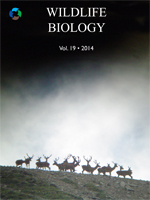Tail-mounted transmitters have been used successfully in temperate regions of North America and Europe but have not been tested in more northern parts of American beaver Castor canadensis range. We deployed 63 tail-mounted transmitters on adult beavers in Voyageurs National Park, Minnesota (USA; 48°30′N, 92°50′W), at the southern edge of the boreal forest. Mean transmitter retention time was 133 days (range = 18–401, SD = 101), with only 7% retained > 12 months. Males and females did not differ in retention times. Retention time was similar for transmitters deployed in fall (n = 38,  = 135 days) and spring (n = 21,
= 135 days) and spring (n = 21,  = 130 days). In 24 cases where we confirmed beavers lost transmitters, 63% tore through the side of the tail, 25% pulled out through a widened attachment hole, and 13% had the lock-nut unscrew. Beavers chewed off or pulled out whip antennas on 50% of transmitters before they were detached from the tail, which reduced VHF signal strength and detection distance. The likelihood that an antenna would be damaged increased 3.8 times for each day of deployment up to 371 days. On average, beavers with transmitters lost 23% of their body mass and 26% of tail thickness over winter, and regained similar percentages over the growing season. Retention rates and retention times of tail transmitters were much lower in Voyageurs National Park relative to more southern areas in the United States where intra-annual variability in body condition is considerably less. Our results reaffirm that methodologies developed for wildlife telemetry or other research and monitoring techniques should be tested under different environmental conditions to ensure objectives can be met in a safe and efficient manner.
= 130 days). In 24 cases where we confirmed beavers lost transmitters, 63% tore through the side of the tail, 25% pulled out through a widened attachment hole, and 13% had the lock-nut unscrew. Beavers chewed off or pulled out whip antennas on 50% of transmitters before they were detached from the tail, which reduced VHF signal strength and detection distance. The likelihood that an antenna would be damaged increased 3.8 times for each day of deployment up to 371 days. On average, beavers with transmitters lost 23% of their body mass and 26% of tail thickness over winter, and regained similar percentages over the growing season. Retention rates and retention times of tail transmitters were much lower in Voyageurs National Park relative to more southern areas in the United States where intra-annual variability in body condition is considerably less. Our results reaffirm that methodologies developed for wildlife telemetry or other research and monitoring techniques should be tested under different environmental conditions to ensure objectives can be met in a safe and efficient manner.
How to translate text using browser tools
1 May 2016
Performance of tail-mounted transmitters on American beavers Castor canadensis in a northern climate
Steve K. Windels,
Jerrold L. Belant





